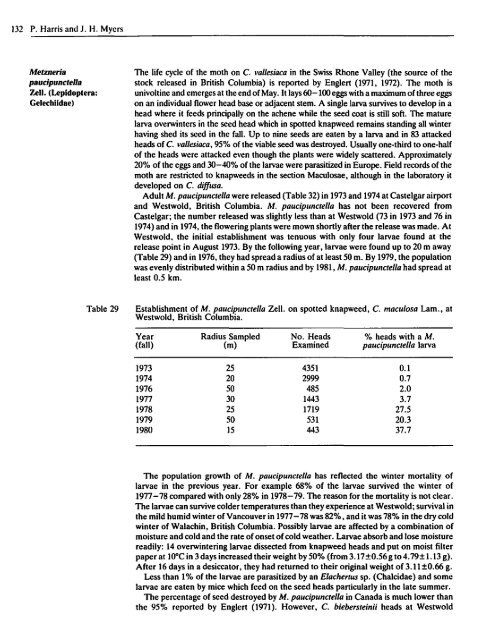pdf, 57.71Mb - Entomological Society of Canada
pdf, 57.71Mb - Entomological Society of Canada
pdf, 57.71Mb - Entomological Society of Canada
Create successful ePaper yourself
Turn your PDF publications into a flip-book with our unique Google optimized e-Paper software.
132 P. Harris and J. H. Myers<br />
Metzneria<br />
paucipuncteJJa<br />
Zell. (Lepidoptera:<br />
Gelechiidae)<br />
Table 29<br />
The life cycle <strong>of</strong> the moth on C. vaJlesiaca in the Swiss Rhone Valley (the source <strong>of</strong> the<br />
stock released in British Columbia) is reported by Englert (1971, 1972). The moth is<br />
univoltine and emerges at the end <strong>of</strong> May. It lays 60-100 eggs with a maximum <strong>of</strong>three eggs<br />
on an individual flower head base or adjacent stem. A single larva survives to develop in a<br />
head where it feeds principally on the achene while the seed coat is still s<strong>of</strong>t. The mature<br />
larva overwinters in the seed head which in spotted knapweed remains standing all winter<br />
having shed its seed in the fall. Up to nine seeds are eaten by a larva and in 83 attacked<br />
heads <strong>of</strong> C. vaJlesiaca, 95% <strong>of</strong> the viable seed was destroyed. Usually one-third to one-half<br />
<strong>of</strong> the heads were attacked even though the plants were widely scattered. Approximately<br />
20% <strong>of</strong> the eggs and 30-40% <strong>of</strong> the larvae were parasitized in Europe. Field records <strong>of</strong> the<br />
moth are restricted to knapweeds in the section MacuIosae, although in the laboratory it<br />
developed on C. diffusa.<br />
Adult M. paucipunctella were released (Table 32) in 1973 and 1974 at Castelgar airport<br />
and Westwold, British Columbia. M. paucipunctella has not been recovered from<br />
Castelgar; the number released was slightly less than at Westwold (73 in 1973 and 76 in<br />
1974) and in 1974, the flowering plants were mown shortly afterthe release was made. At<br />
Westwold, the initial establishment was tenuous with only four larvae found at the<br />
release point in August 1973. By the following year, larvae were found up to 20 m away<br />
(Table 29) and in 1976, they had spread a radius <strong>of</strong> at least 50 m. By 1979, the population<br />
was evenly distributed within a 50 m radius and by 1981, M. paucipunctella had spread at<br />
least 0.5 km.<br />
Establishment <strong>of</strong> M. paucipunctella Zell. on spotted knapweed, C. maculosa Lam., at<br />
Westwold, British Columbia.<br />
Year<br />
(fall)<br />
1973<br />
1974<br />
1976<br />
1977<br />
1978<br />
1979<br />
1980<br />
Radius Sampled<br />
(m)<br />
25<br />
20<br />
50<br />
30<br />
25<br />
50<br />
15<br />
No. Heads<br />
Examined<br />
4351<br />
2999<br />
485<br />
1443<br />
1719<br />
531<br />
443<br />
% heads with a M.<br />
paucipunctella larva<br />
0.1<br />
0.7<br />
2.0<br />
3.7<br />
27.5<br />
20.3<br />
37.7<br />
The population growth <strong>of</strong> M. paucipunctella has reflected the winter mortality <strong>of</strong><br />
larvae in the previous year. For example 68% <strong>of</strong> the larvae survived the winter <strong>of</strong><br />
1977-78 compared with only 28% in 1978-79. The reason for the mortality is not clear.<br />
The larvae can survive colder temperatures than they experience at Westwold; survival in<br />
the mild humid winter <strong>of</strong> Vancouver in 1977-78 was 82%, and it was 78% in the dry cold<br />
winter <strong>of</strong> Walachin, British Columbia. Possibly larvae are affected by a combination <strong>of</strong><br />
moisture and cold and the rate <strong>of</strong> onset <strong>of</strong> cold weather. Larvae absorb and lose moisture<br />
readily: 14 overwintering larvae dissected from knapweed heads and put on moist filter<br />
paper at 1000C in 3 days increased their weight by 50% (from 3.17±0.56 g to 4. 79± 1.13 g).<br />
After 16 days in a desiccator, they had returned to their original weight <strong>of</strong> 3.11±0.66 g.<br />
Less than 1% <strong>of</strong> the larvae are parasitized by an Elachertus sp. (Chalcidae) and some<br />
larvae are eaten by mice which feed on the seed heads particularly in the late summer.<br />
The percentage <strong>of</strong> seed destroyed by M. paucipunctella in <strong>Canada</strong> is much lower than<br />
the 95% reported by Englert (1971). However, C. biebersteinii heads at Westwold
















